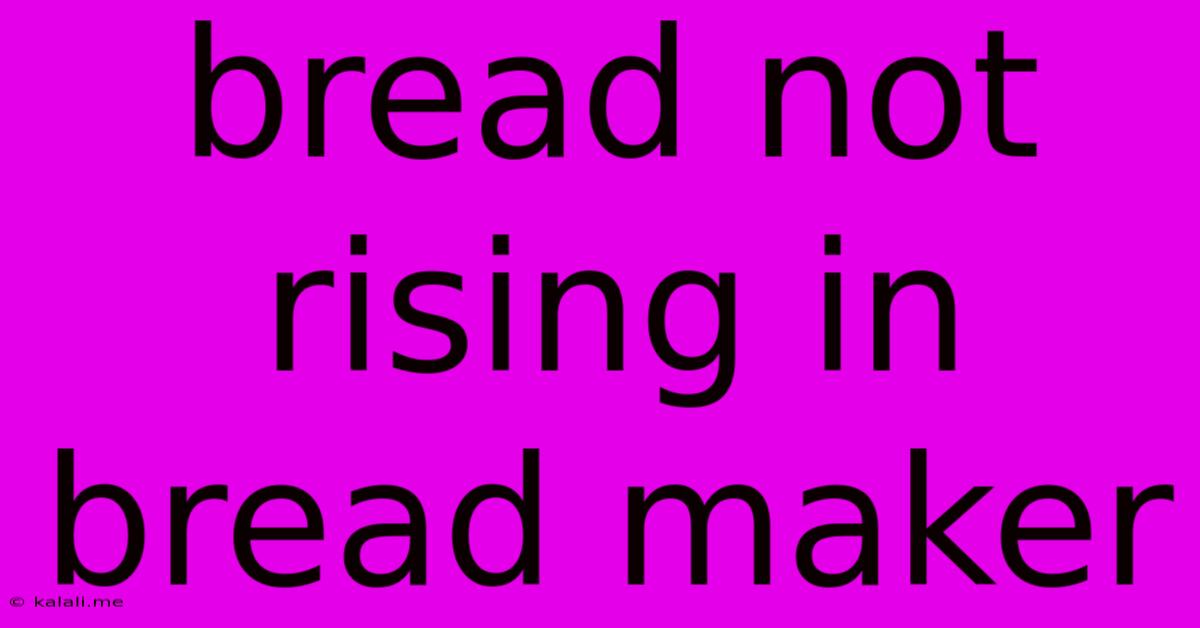Bread Not Rising In Bread Maker
Kalali
May 21, 2025 · 3 min read

Table of Contents
Why Isn't My Bread Rising in the Bread Maker? Troubleshooting Common Issues
So, you’ve loaded your ingredients into your trusty bread maker, selected your favorite setting, and eagerly awaited a perfectly risen loaf. But instead, you’re greeted with a flat, dense disappointment. Don't despair! Many factors can contribute to bread not rising in a bread maker. This comprehensive guide will walk you through the most common culprits and offer solutions to get your bread rising beautifully. This article will cover ingredient issues, machine problems, and recipe considerations to help you troubleshoot and bake the perfect loaf.
Understanding the Rising Process: Before we dive into troubleshooting, let's briefly understand the process. Yeast, the leavening agent, needs the right environment to activate and produce carbon dioxide, causing the dough to rise. This requires the correct temperature, moisture, and sufficient time.
Common Reasons for Bread Maker Failure to Rise:
1. Ingredient Issues: The Foundation of a Good Rise
- Inactive Yeast: This is the most frequent reason. Old yeast loses its potency. Check the expiration date; if it's past its prime, replace it. Even fresh yeast can be inactive if stored improperly. Ensure it’s stored in a cool, dry place.
- Incorrect Yeast Amount: Too little yeast will result in slow or no rise. Too much can lead to a fast, uneven rise and a potentially sour taste. Always measure carefully using a kitchen scale for precise measurements. Volume measurements can be inaccurate.
- Incorrect Flour Type: Using the wrong type of flour can drastically affect the rise. Bread flour, with its higher protein content, is ideal for bread making as it produces stronger gluten. All-purpose flour can work but may result in a less airy loaf.
- Salt Interference: While salt is crucial for flavor and dough development, adding too much can inhibit yeast activity. Double-check your recipe measurements.
- Incorrect Liquid Temperature: Yeast thrives in warm conditions. Water that is too hot will kill the yeast, while water that is too cold will slow down or prevent activation. Aim for lukewarm water (around 105-115°F or 40-46°C).
- Stale Ingredients: Using old flour or other stale ingredients can negatively impact the rising process. Fresh ingredients are key for optimal results.
2. Machine Problems: Ensuring Your Bread Maker is Working Correctly
- Faulty Heating Element: A malfunctioning heating element in your bread maker can affect the ideal temperature for yeast activity, hindering the rising process. Check your bread maker's manual for troubleshooting steps.
- Improper Kneading: The bread maker's kneading function is crucial for developing gluten. If the kneading is insufficient, the dough won't develop the necessary structure for proper rising. Check the kneading cycle and ensure the dough is well-mixed and elastic.
- Machine Malfunction: In rare cases, the bread maker itself might be faulty. Check the manufacturer's warranty and consider contacting customer support.
3. Recipe Considerations: Tweaking Your Approach
- Recipe Accuracy: Always follow the recipe precisely, especially concerning ingredient ratios and baking time. Even small variations can impact the outcome.
- Altitude Adjustment: If you live at a high altitude, you might need to adjust your recipe. High altitudes require alterations to compensate for the lower air pressure.
- Room Temperature: A very cold kitchen can impact the rising process. Consider preheating your oven briefly before baking to warm the kitchen slightly.
Troubleshooting Tips:
- Proof the Yeast: Before adding yeast to the bread maker, dissolve it in warm water with a pinch of sugar. If it foams within 5-10 minutes, the yeast is active.
- Check the Dough: Open the bread maker during the rising cycle to check the dough's consistency. It should be smooth, soft, and slightly puffy.
- Clean Your Bread Maker: A clean bread maker is essential. Crumbs and leftover dough can interfere with future bakes.
By addressing these potential issues, you'll significantly increase your chances of baking a perfectly risen loaf in your bread maker. Remember to always carefully follow your recipe, and don't be afraid to experiment and learn from your experiences! Happy baking!
Latest Posts
Latest Posts
-
How To Get Food Coloring Off Skin
May 21, 2025
-
Do Xbox One Controllers Work With Xbox 360
May 21, 2025
-
Fire Transfers Heat Energy From The Flames
May 21, 2025
-
Can You Eat Beef Burgers Pink
May 21, 2025
-
Wire A Light With A Switch
May 21, 2025
Related Post
Thank you for visiting our website which covers about Bread Not Rising In Bread Maker . We hope the information provided has been useful to you. Feel free to contact us if you have any questions or need further assistance. See you next time and don't miss to bookmark.